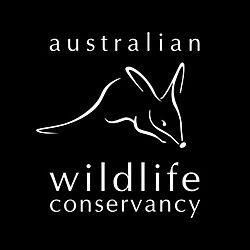Australian Wildlife Conservancy facts for kids
 |
|
| Formation | 2001 |
|---|---|
| Founder | Martin Copley |
| Type | Nonprofit organisation |
| Location |
|
The Australian Wildlife Conservancy (AWC) is a special group in Australia. It is a nonprofit organisation, which means it uses all its money to help its cause, not to make a profit for owners. AWC works to protect Australia's amazing wildlife and the places they live, called ecosystems.
AWC is the biggest private group in Australia that owns and manages land for conservation. They currently look after 31 sanctuaries and partner with other groups. These areas cover over 6.5 million hectares across Australia. They work with government groups, Indigenous communities, and private landowners to protect these areas. Most of their money comes from people who donate, but they also get some government grants for specific projects.
In 2022, AWC started a new project to help the Northern Quoll. They teamed up with other groups like Territory Natural Resource Management and James Cook University. They are trying out new ways to help quolls, like building artificial dens and using carefully planned fires to manage the land.
Contents
Protecting Australia's Wildlife
The Australian Wildlife Conservancy was created because many Australian mammals were disappearing. Over the last 400 years, more than a third of all animal extinctions worldwide have happened in Australia. Australia has already lost 31 types of mammals forever. Many of these could have been saved with good conservation efforts.
AWC's Unique Approach to Conservation
AWC uses a special way to protect nature. They use science to guide their work. This means they do a lot of surveys to count animals and plants. They also do research to understand what animals need. This information helps them manage the land. They control things like wildfires, feral animals (animals that are not native and cause harm), and weeds (plants growing where they are not wanted).
AWC focuses a lot on protecting wildlife. About 80% of their staff work directly in the field. In 2021, most of AWC's money was spent on conservation programs.
The Start of AWC: Karakamia Sanctuary
The idea for AWC began in 1991. AWC's founder, Martin Copley, bought some land. This land is now called Karakamia Sanctuary. He built a special fence to keep out feral animals. After clearing the area of these harmful animals, he started bringing back threatened mammals.
Karakamia Sanctuary is still open for tours at night. On these tours, you can see small mammals like the woylie (also called a brush-tailed bettong), tammar wallaby, quenda, and common brushtail possum. In 2001, AWC officially became a public charitable organization.
Growing the Conservation Network
In 2002, AWC bought four more sanctuaries: Buckaringa, Dakalanta, Scotia, and Yookamurra. These were purchased from another conservation company. In 2007, AWC also started working with the company Optus.
A report in 2016 showed that Australia has amazing biodiversity (many different kinds of life). However, it also showed that many species were still disappearing. AWC works to protect many different types of habitats across its network of sanctuaries. This helps protect 88% of Australia's bird species, 74% of mammals, 54% of reptile species, and 56% of amphibian species.
New Partnerships for Wildlife
In 2019, AWC started a partnership with Bullo River Station. This is a large cattle property in the Northern Territory. This partnership is special because it helps both wildlife and cattle. The area has rocky gorges, lush riverside plants, and tropical woodlands. Surveys have already found important rare and threatened animals there. These include the Gouldian finch and the wyulda, also known as the scaly-tailed possum.
In 2021, AWC launched the Western River Refuge project. This was in response to the big bushfires on Kangaroo Island in 2020. This project created a 369-hectare safe area. It has a fence to keep out feral predators. This safe area helps protect the Kangaroo Island dunnart and other threatened species.
AWC Sanctuaries Across Australia
As of 2024, AWC manages many sanctuaries. These are special protected areas where wildlife can thrive. Here are some of their locations:
- Bowra, Queensland
- Brooklyn, Queensland
- Buckaringa, South Australia
- Bullo River Station, Northern Territory
- Charnley River–Artesian Range Wildlife Sanctuary, Western Australia
- Curramore, Queensland
- Dakalanta, South Australia
- Dambimangari Country, Western Australia
- Faure Island, Western Australia
- Kalamurina, South Australia
- Karakamia, Western Australia
- Mallee Cliffs National Park, New South Wales
- Marion Downs, Western Australia
- Mornington, Western Australia
- Mount Gibson, Western Australia
- Mount Zero-Taravale, Queensland
- Newhaven, Northern Territory
- Paruna, Western Australia
- Piccaninny Plains, Queensland
- Pungalina-Seven Emu, Northern Territory
- Richard Underwood Nature Refuge (RUNR), near St George, Queensland
- Scotia, New South Wales
- Tableland, Western Australia
- The Pilliga, New South Wales
- The Western River Refuge, Kangaroo Island, South Australia
- Wilinggin, Western Australia
- Wongalara, Northern Territory
- Yampi Sound Training Area, Western Australia
- Yookamurra, South Australia

